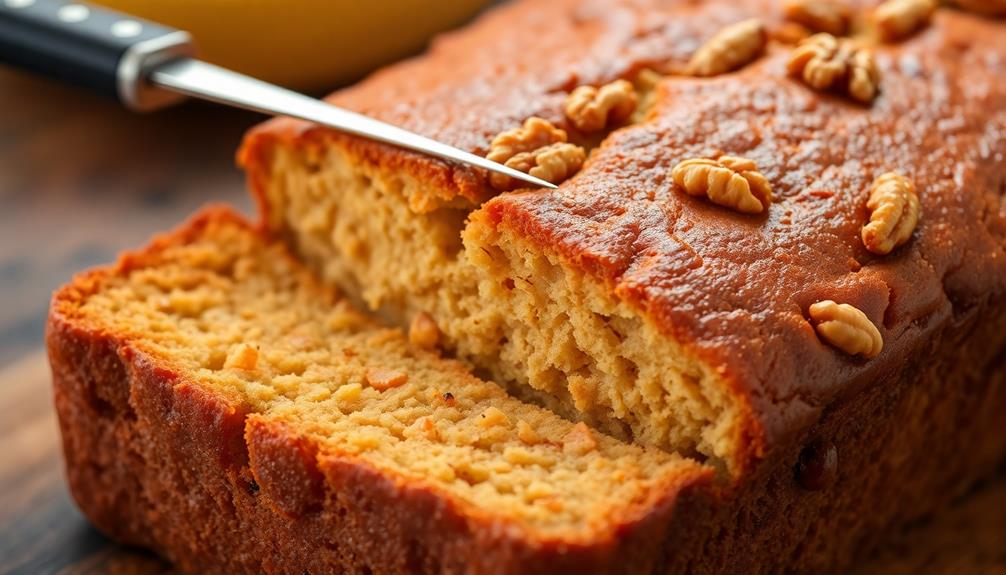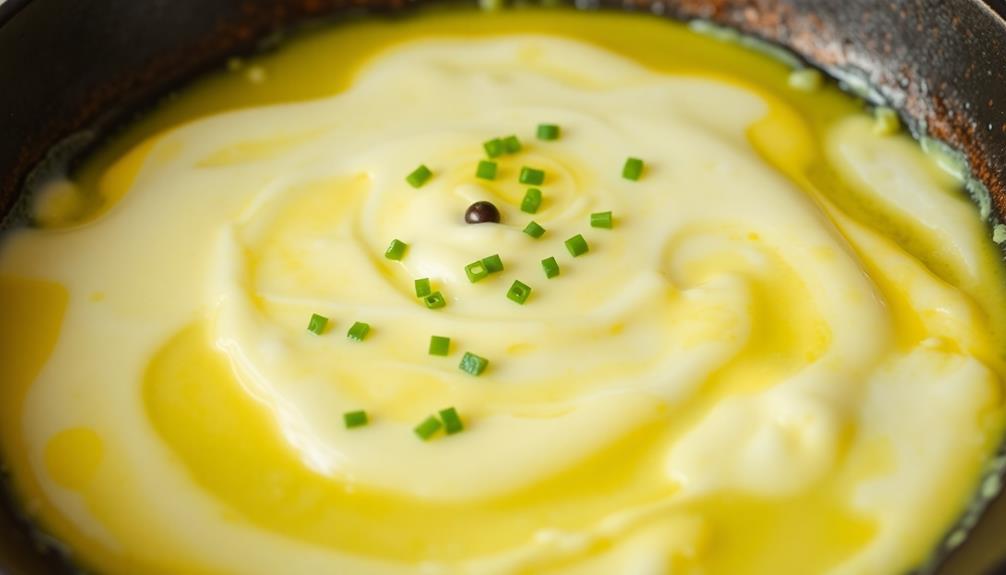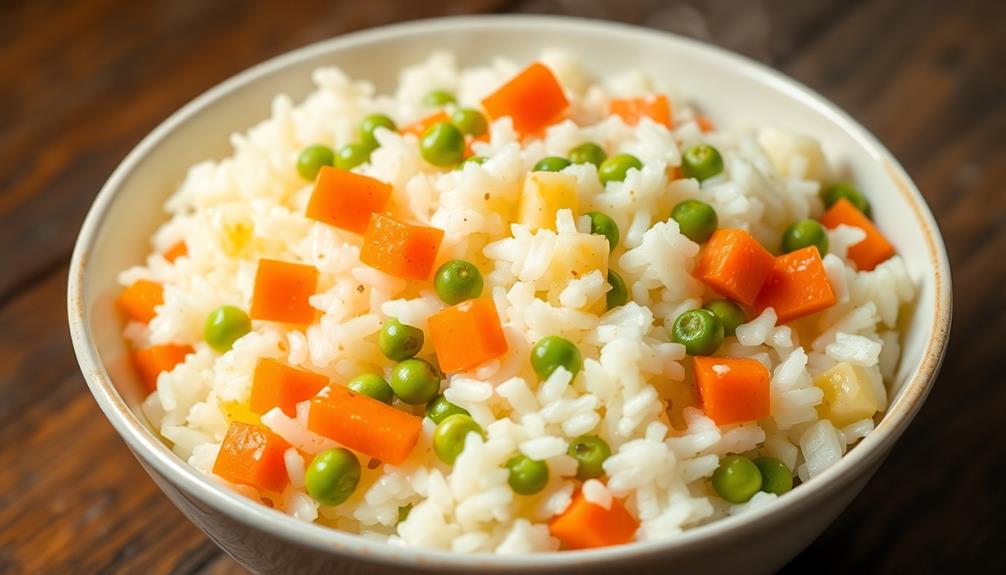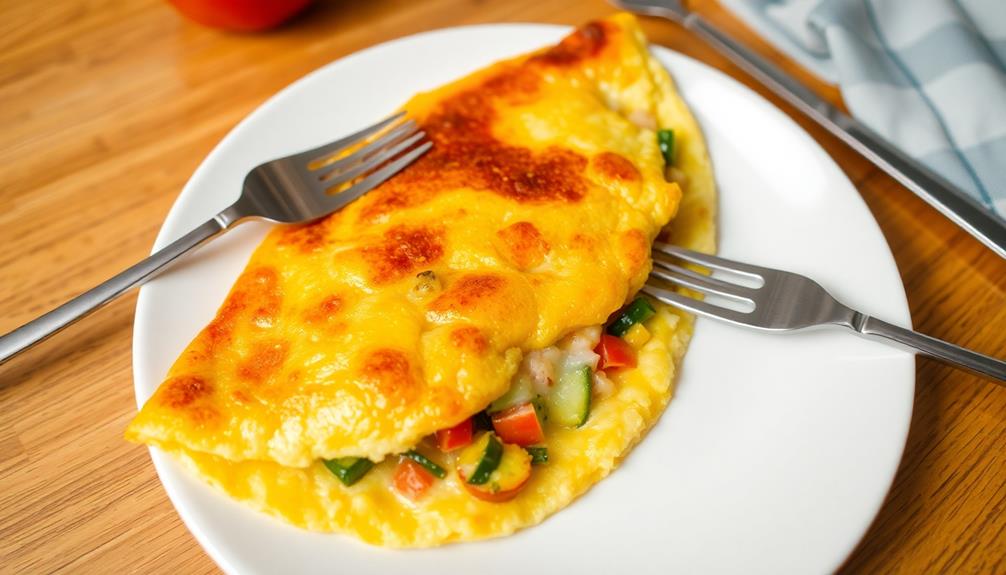Craft moist, flavorful banana bread like a pro with this comprehensive guide. The origins date back to the early 20th century, when folks repurposed overripe bananas during tough times. Today, this beloved comfort food remains a staple, featuring a classic recipe with 1 3/4 cups flour, 1 tsp baking soda, and 1/2 cup softened butter. Cream the butter and sugar, then gently fold in the mashed bananas. Bake until fragrant, and allow to cool before slicing. Enjoy the sweet banana flavor and tender crumb as a snack, breakfast, or dessert. For more ways to customize and elevate your banana bread, read on.
Key Takeaways
- A classic banana bread recipe featuring key ingredients like all-purpose flour, baking soda, and ripe bananas for a moist and flavorful loaf.
- Straightforward preparation steps, including creaming butter and sugar, gradually incorporating eggs and dry ingredients, and folding in mashed bananas.
- Baking tips such as preheating the oven, gradual egg incorporation, and avoiding overmixing to achieve the perfect texture.
- Versatile banana bread that can be enjoyed as a snack, breakfast, or dessert, with options for customization like adding chocolate chips, nuts, or a light glaze.
- The ability to create lasting memories and bonds through the sharing of homemade banana bread, a beloved American comfort food.
History

The origins of banana bread can be traced back to the early 20th century, when resourceful homemakers sought to repurpose overripe bananas. During the Great Depression, wasting food was unthinkable, so these savvy cooks mashed up those spotty bananas and incorporated them into quick bread recipes. The result? A moist, sweet loaf that quickly became a staple in American households.
As bananas grew in popularity and availability throughout the 20th century, banana bread evolved. Bakers experimented with add-ins like walnuts, chocolate chips, and spices, transforming the humble loaf into a true culinary delight.
Today, banana bread remains a beloved comfort food, enjoyed for breakfast, snacks, and dessert. Its enduring popularity is a testament to the creativity and ingenuity of those early banana bread pioneers, who turned kitchen scraps into something truly special.
Recipe
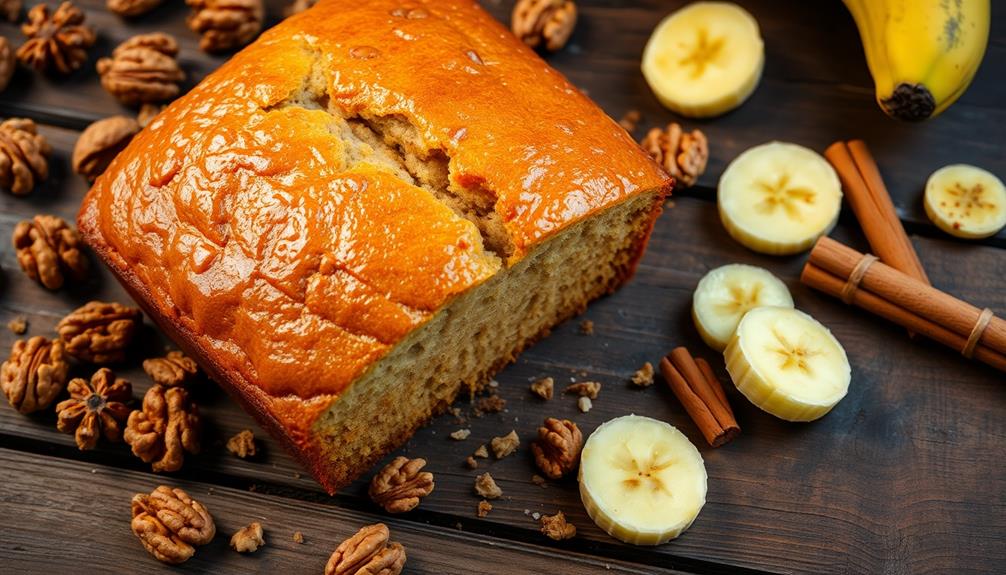
Banana bread is a delightful and versatile treat that can be enjoyed for breakfast, snack, or dessert. This classic recipe yields a moist, flavorful loaf that's sure to delight your taste buds. The combination of ripe bananas, warm spices, and a tender crumb makes for a comforting and satisfying baked good.
Preparing this banana bread is a straightforward process that can be easily mastered by both novice and experienced bakers. The recipe is adaptable, allowing you to customize it to your preferences, whether you prefer a sweeter loaf, a nutty addition, or a touch of cinnamon. To achieve the best texture, make sure to use overripe bananas, as they provide natural sweetness and moisture to the loaf. If you’re looking for additional homemade bread baking tips, consider mixing your dry ingredients separately from the wet to avoid overmixing the batter, which can result in a denser bread. For added flavor, try incorporating chocolate chips or toasted walnuts into the mixture before baking. Once you’ve mastered the basics of this recipe, you can experiment by adding your favorite mix-ins or creating a healthier version with whole wheat flour or natural sweeteners. Learning how to make homemade bread like this banana loaf can be a gateway to exploring other types of breads, from savory to sweet. With just a few simple techniques, you’ll be able to create a freshly baked treat that’s both comforting and versatile.
Ingredients:
- 1 3/4 cups all-purpose flour
- 1 teaspoon baking soda
- 1/4 teaspoon salt
- 1/2 cup unsalted butter, softened
- 3/4 cup granulated sugar
- 2 large eggs
- 1 1/2 cups mashed ripe bananas (about 3 medium bananas)
- 1 teaspoon vanilla extract
Preheat your oven to 350°F (177°C). Grease a 9×5-inch loaf pan with butter or non-stick cooking spray. In a medium bowl, whisk together the flour, baking soda, and salt.
In a large bowl, cream the butter and sugar until light and fluffy. Beat in the eggs one at a time, then stir in the mashed bananas and vanilla. Gradually fold the dry ingredients into the wet ingredients until just combined, being careful not to overmix.
Pour the batter into the prepared loaf pan and smooth the top. For optimal results, allow the banana bread to cool completely before slicing. This allows the flavors to develop and the texture to set.
Enjoy your homemade banana bread on its own or with a spread of butter or cream cheese. For a touch of indulgence, you can also top it with a drizzle of honey or a sprinkle of chopped nuts.
Cooking Steps

First, preheat your oven to 350°F.
Then, cream the butter and sugar together until light and fluffy.
Next, add the eggs one by one, mixing well after each addition before folding in the mashed bananas.
Step 1. Preheat Oven to 350°F
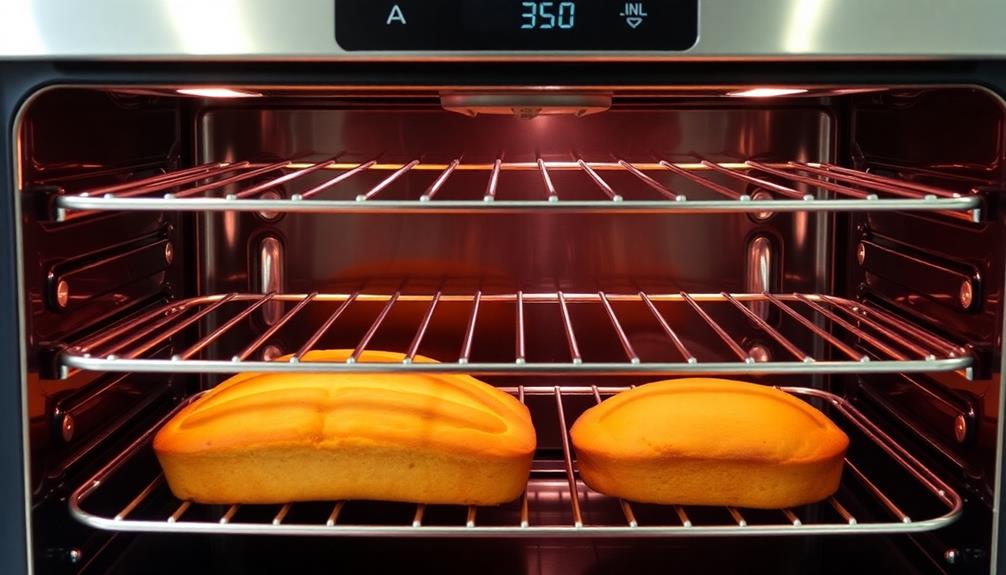
Preheating the oven sets the stage for baking perfection, ensuring your banana bread cooks evenly and rises beautifully. This important step shouldn't be overlooked – it's the key to achieving that perfect, golden-brown crust and moist, fluffy interior.
To properly preheat your oven, start by adjusting the oven rack to the middle position. This allows for even heat distribution throughout the baking process.
Next, set the temperature to 350°F. It's crucial to wait until the oven has fully preheated before placing your banana bread batter inside. This typically takes around 15 minutes, though oven times can vary.
Once the oven is ready, use oven mitts to carefully slide the banana bread pan onto the middle rack. Close the oven door quickly to maintain the temperature.
Resist the urge to open the door during baking, as this can cause the bread to collapse. With the oven properly preheated, you're now ready to bake your delicious banana bread to perfection.
Step 2. Cream Butter and Sugar Together
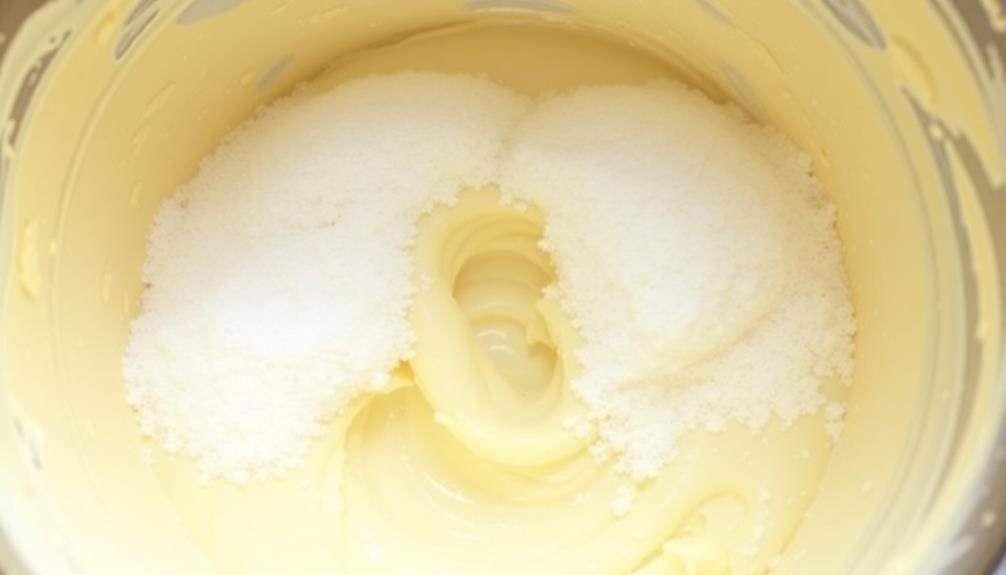
With butter and sugar at the ready, begin creaming them together using a hand mixer or stand mixer. This important step in the banana bread recipe helps incorporate air into the batter, resulting in a light and fluffy texture.
Cream the butter and sugar on medium speed for 2-3 minutes, until the mixture is pale and fluffy. Be sure to scrape down the sides of the bowl periodically to ensure even mixing.
The reason this step is so crucial is that creaming the butter and sugar together creates tiny air pockets that expand during baking, causing the bread to rise. If you skip this step or don't cream them long enough, your banana bread may end up dense and heavy.
Pay close attention to the texture and consistency – you'll know it's ready when the mixture is light and airy. With the butter and sugar perfectly creamed, you're one step closer to baking up a delicious loaf of homemade banana bread.
Step 3. Add Eggs One by One
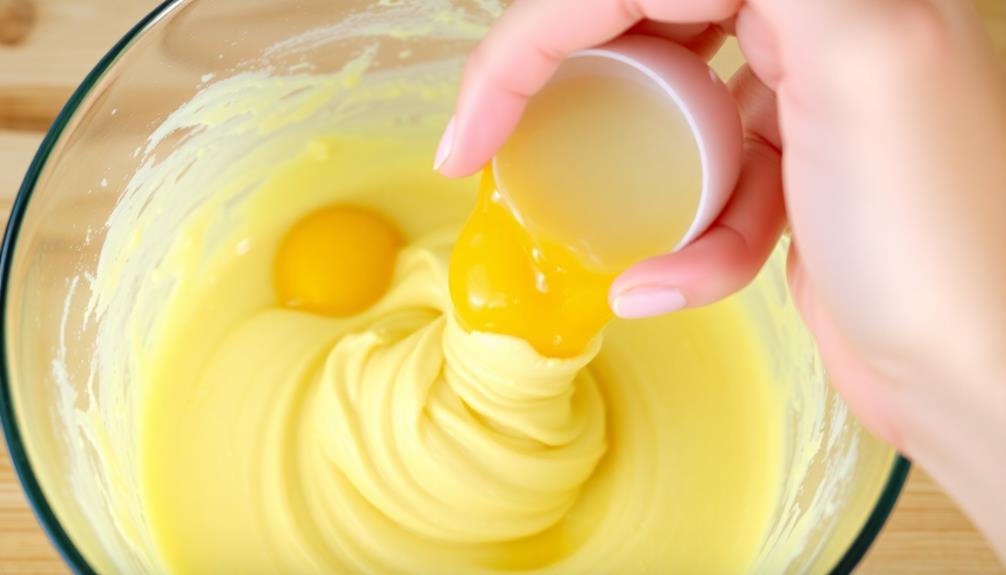
Next, crack the eggs into a small bowl, one at a time, beating well after each addition. This step helps emulsify the batter, creating a smooth, cohesive texture. Be sure to incorporate each egg fully before moving on to the next. This gradual incorporation prevents the batter from becoming overworked, which can result in a dense, tough crumb.
Once all the eggs have been added and thoroughly mixed in, the batter will take on a richer, more uniform appearance. This eggy base is essential for achieving the classic banana bread's moist, tender interior. The proteins in the eggs help bind the ingredients together, while the fat and moisture they provide contribute to the bread's soft, cake-like structure.
Remember to scrape down the sides of the bowl periodically to ensure all the ingredients are evenly incorporated. This step helps create a cohesive, well-mixed batter that will bake up beautifully.
Step 4. Slowly Add Dry Ingredients

After incorporating the eggs, it's time to slowly add the dry ingredients to the batter. This step is crucial for achieving the perfect texture and rise in your banana bread. In a medium bowl, whisk together the flour, baking soda, and salt until well combined.
Now, with your mixer on low speed, gradually add the dry ingredients to the wet batter, mixing just until they're incorporated. Be careful not to overmix, as this can lead to a dense, tough bread. Scrape down the sides of the bowl as needed to ensure all the ingredients are evenly distributed.
Once the dry ingredients are fully incorporated, the batter should be smooth and free of any dry pockets. At this point, you can gently fold in any add-ins you desire, such as chopped nuts or chocolate chips.
Just be sure not to overmix the batter when doing so. Now you're ready to pour the batter into your prepared loaf pan and bake your delicious banana bread!
Step 5. Fold in Mashed Bananas
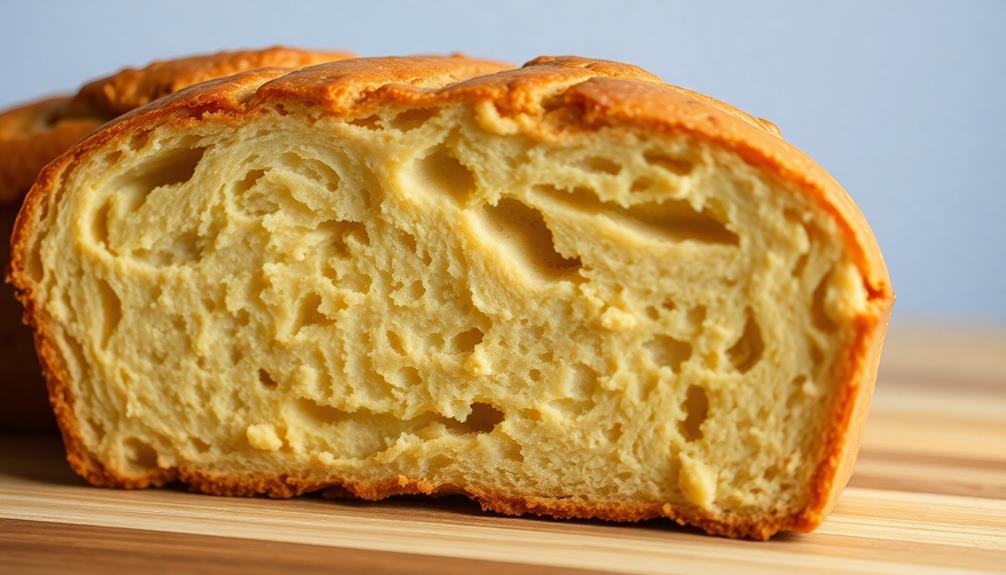
In the next step, fold the mashed bananas into the batter. This is a crucial moment, as the bananas will lend both moisture and flavor to the bread.
Gently incorporate the bananas using a rubber spatula, folding the mixture in a circular motion to avoid overmixing. The goal is to evenly distribute the bananas throughout the batter without deflating the air pockets you've built up.
Pay close attention as you fold – you want the bananas to be fully integrated, but don't overdo it. Ideally, you'll see streaks of banana running through the batter, creating a beautiful marbled effect.
Once the bananas are evenly dispersed, your batter is ready to be poured into the prepared loaf pan.
Be gentle yet thorough in this step. The mashed bananas will add wonderful flavor and moisture to your final loaf, so take the time to fold them in with care.
With the bananas now incorporated, you're one step closer to enjoying a perfect slice of homemade banana bread.
Final Thoughts

Typically, the last step in baking banana bread is to enjoy the fruits of your labor. You've carefully followed the recipe, from mashing the ripe bananas to folding them into the batter. Now, it's time to savor the warm, fragrant loaf you've created.
The blend of sweet banana and comforting spices is sure to delight your senses. As you slice into the bread, note the moist, tender crumb and the occasional burst of banana flavor.
Consider the versatility of this recipe – it can be enjoyed as a snack, for breakfast, or even as a dessert. Pair it with a cup of coffee or tea for a cozy moment of indulgence.
Don't be afraid to experiment with mix-ins or toppings, such as chocolate chips, nuts, or a light glaze. The possibilities are endless, allowing you to make this classic recipe your own.
Ultimately, the true joy of banana bread lies in sharing it with loved ones and creating lasting memories around the table.
Frequently Asked Questions
Can I Use Overripe Bananas for Banana Bread?
You can absolutely use overripe bananas for your banana bread! In fact, they're the ideal choice. The riper the bananas, the sweeter and more moist your bread will turn out. Give it a try!
How Do I Prevent My Banana Bread From Being Dry?
To prevent your banana bread from being dry, use overripe bananas, which are naturally sweeter and more moist. Additionally, don't overbake the bread and consider adding a tablespoon of oil or yogurt to the batter.
Can I Substitute Oil for Butter in the Recipe?
You can substitute oil for butter in the banana bread recipe, but the texture and flavor may differ. The oil will create a more moist and dense crumb, while butter provides a richer taste. Try experimenting to find your preferred result.
How Long Does Homemade Banana Bread Stay Fresh?
Homemade banana bread typically stays fresh for 3-5 days when stored at room temperature in an airtight container. For longer storage, you can freeze it for up to 3 months, which will help preserve its freshness.
Can I Freeze Banana Bread for Later?
Absolutely! You can easily freeze banana bread for later enjoyment. Just wrap it tightly in plastic wrap or foil, and it'll stay fresh in the freezer for up to 3 months. Thaw it at room temperature when you're ready to indulge.
